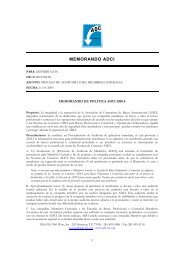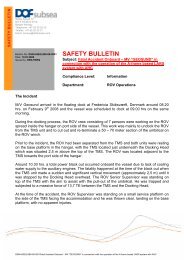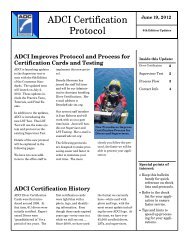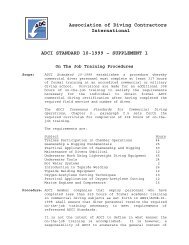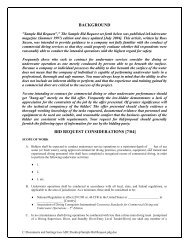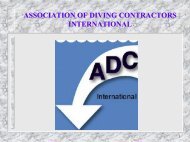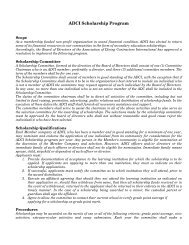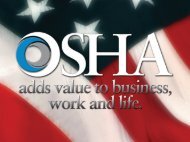DIRECTIVE NUMBER: CPL 02-00-151 EFFECTIVE DATE ... - OSHA
DIRECTIVE NUMBER: CPL 02-00-151 EFFECTIVE DATE ... - OSHA
DIRECTIVE NUMBER: CPL 02-00-151 EFFECTIVE DATE ... - OSHA
Create successful ePaper yourself
Turn your PDF publications into a flip-book with our unique Google optimized e-Paper software.
(see Federal Register notice 49 FR 29105), that reopened the record, and required a<br />
determination of the interpretive guidelines that <strong>OSHA</strong> proposed to use in determining which<br />
enterprises may avail themselves of the exemption for scientific diving. Final action regarding<br />
this court order was concluded and published by <strong>OSHA</strong> on January 9, 1985 (see Federal Register<br />
notice 50 FR 1046), Commercial Diving Operations – Exemption for Scientific Diving – Final<br />
Guidelines. This notice established the final guidelines that <strong>OSHA</strong> uses, in conjunction with the<br />
exemption criteria contained in the final rule (see Federal Register notice 47 FR 53357 and 29<br />
CFR 1910.401(a)(2)(iv)), to determine whether a scientific diving program can avail itself of the<br />
exemption from the <strong>OSHA</strong> commercial diving standard. The absence of any factor specified in<br />
the guidelines (see Appendix B to 29 CFR Part 1910, Subpart T – Commercial Diving<br />
Operations), or the final rule (see 29 CFR 1910.401(a)(2)(iv)), renders a diving program<br />
ineligible for the exemption.<br />
SCIENTIFIC DIVING EXEMPTION – DISCUSSION OF THE FINAL RULE AND<br />
GUIDELINES<br />
The final rule at 29 CFR 1910.401(a)(2)(iv), which became effective on November 26, 1982,<br />
exempts any diving operation that is defined as scientific diving, and that is under the direction<br />
and control of a diving program containing at least the following elements:<br />
(A) Diving safety manual that includes, at a minimum: Procedures covering all diving<br />
operations specific to the program; procedures for emergency care, including recompression and<br />
evacuation; and criteria for diver training and certification.<br />
(B) Diving control (safety) board, with the majority of its members being active divers, which<br />
shall, at a minimum, have the authority to: approve and monitor diving projects; review and<br />
revise the diving safety manual; ensure compliance with the manual; certify the depths to which<br />
a diver has been trained; take disciplinary action for unsafe practices; and assure adherence to<br />
the buddy system (i.e., a diver is accompanied by, and is in continuous contact, with another<br />
diver in the water) for SCUBA diving.<br />
In addition to the final rule, Appendix B to 29 CFR Part 1910, Subpart T – Commercial Diving<br />
Operations, titled “Guidelines for Scientific Diving,” became effective on January 9, 1985. This<br />
appendix provides guidelines that are used in conjunction with the final rule to determine those<br />
scientific diving programs that are exempt from <strong>OSHA</strong>’s diving standard. The guidelines are as<br />
follows:<br />
1. “The Diving Control (safety) Board consists of a majority of active scientific divers and has<br />
autonomous and absolute authority over the scientific diving program’s operations.”<br />
The first guideline concerns organizational structure. <strong>OSHA</strong> concluded that the organizational<br />
structure of the scientific diving community’s consensual standard program is not only vital to<br />
the integrity of scientific diving programs, but effectively serves to segregate scientific diving<br />
from commercial diving. The Diving Control Board required for scientific diving programs<br />
must contain several elements that distinguish the exempt scientific diving programs from<br />
commercial diving. These distinctive elements include absolute authority over diving<br />
operations, the autonomy inherent in the Diving Control Board’s decision making powers and<br />
responsibilities, and peer review. <strong>OSHA</strong>’s intent was for the Diving Control Board, primarily<br />
C-5


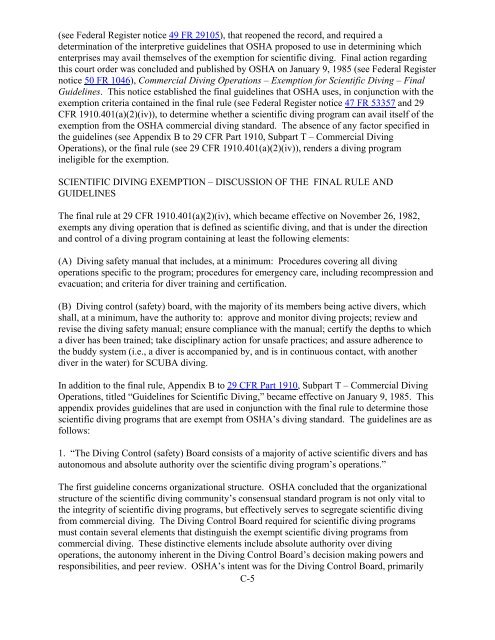
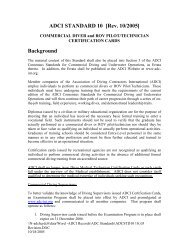
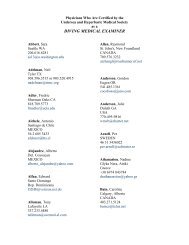
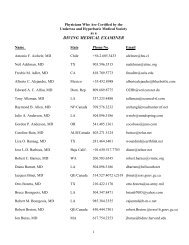
![SOLICITUD MEMBRESIA ASOCIADO [Rev 06/08] - Association of ...](https://img.yumpu.com/48291988/1/190x245/solicitud-membresia-asociado-rev-06-08-association-of-.jpg?quality=85)

